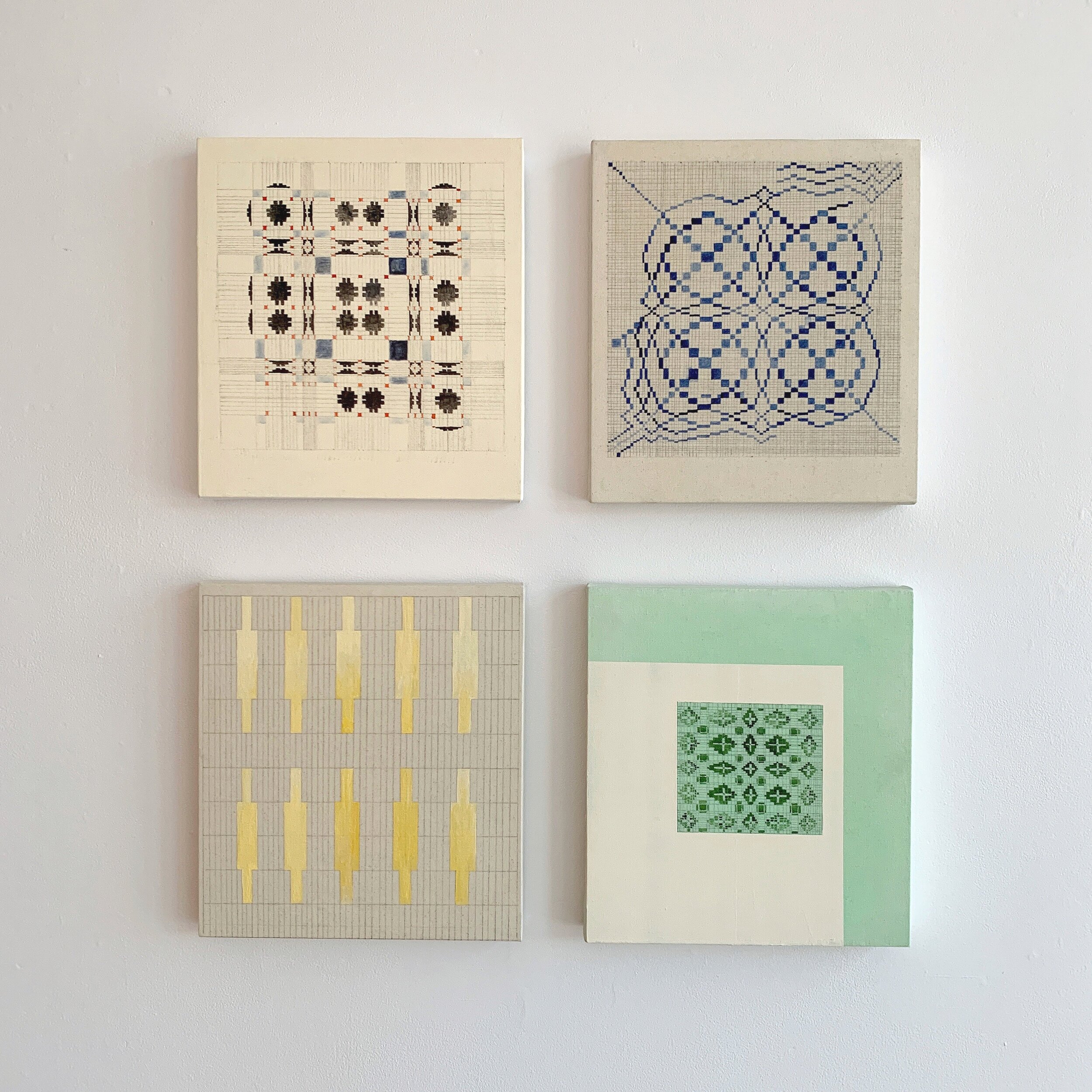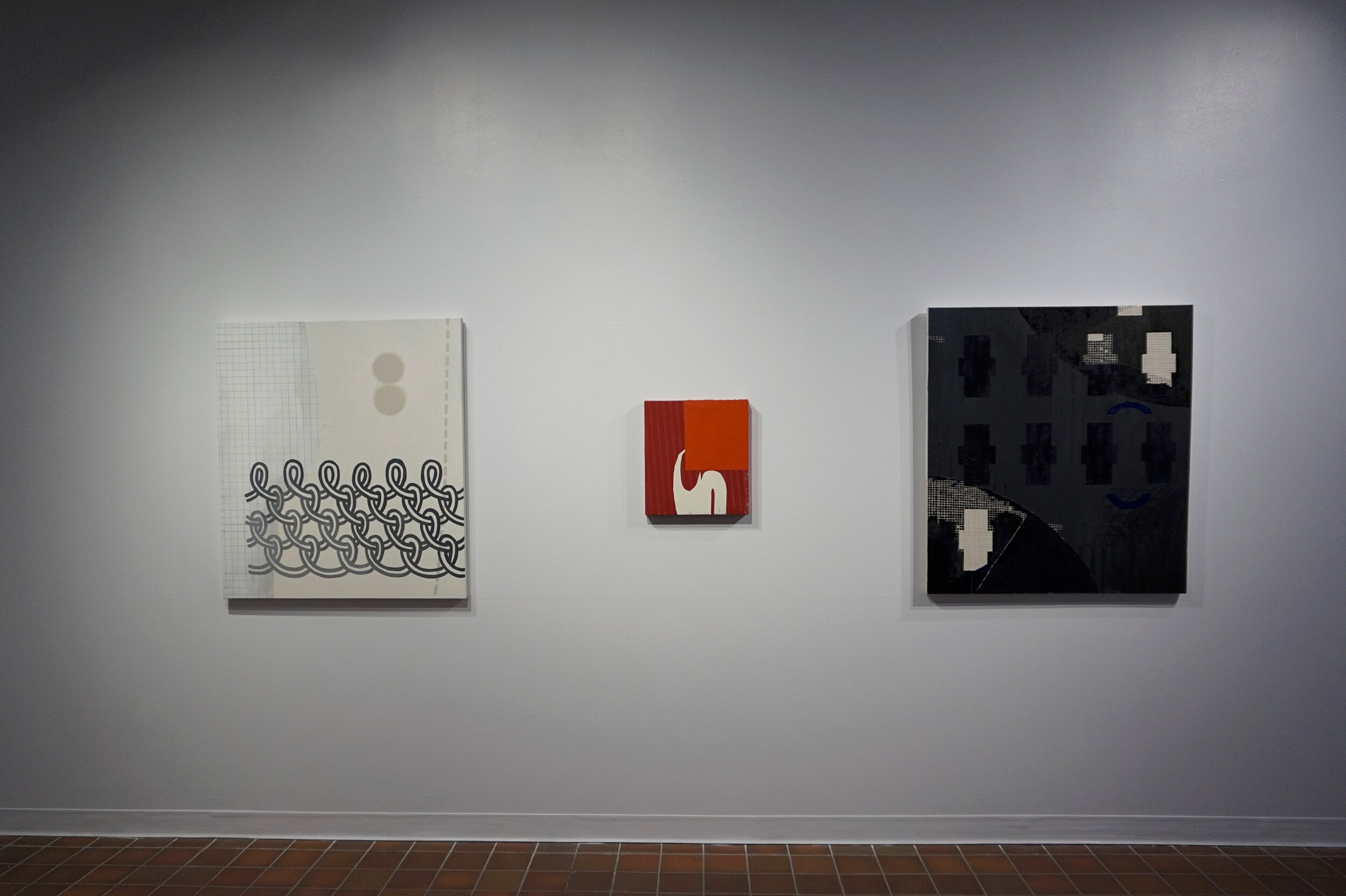(Im)MATERIAL Solo Exhibition
Cipher, 2020, Acrylic and graphite on canvas, 72” x 80”
Artist Statment
The relationship between ancient craft practices, “women’s work”, and technology is the primary focus of my artwork. Using the grid as a visual and conceptual link, I investigate the roots of modern technology in hand weaving practices. The structure of the grid can be traced back to the crossing of threads at right angles for the purposes of weaving cloth. Today, the grid structure often references virtual space and computer imagery. My work considers the space between digital and analog, old and new, hand and machine.
Through extensive work within local weaving communities, I have been handed down diagrams, pattern information, techniques and stories. My artworks record and interpret these patterns and imagery, either directly or through the use of symbols. Alternating between analog and digital methods of production, I use a Trotec laser cutter alongside traditional painting media. The resulting artworks reference both weaving patterns and digital code.
Engaging with traditions of modernist and minimalist painting, my work builds upon the work of artists like Hilma af Klint, Agnes Martin and Anni Albers. These artists use the grid as a visual structure to diagram and understand scientific, material and spiritual ideas. My work reconsiders these ideas in light of society’s changing relationship to technology. Reconsidering the role of textile work traditionally done by women has potential to reclaim female authorship in the development of contemporary ideas and influence our collective future.
Interview with Erik Einsiedel
How would you describe (IM)MATERIAL?
As technology advances and our world shifts towards the digital, society is losing the material knowledge formed by making things by hand. My work explores how ancient craft practices and contemporary technology are inextricably linked. Using the structure of the grid, I investigate visual relationships between weaving patterns and digital space. Reconsidering the value of ancient craft techniques has potential to revitalize contemporary experience and influence our collective future.
What was your inspiration for the exhibition?
My work incorporates ideas from my own experience engaging with local weavers and makers, as well as my experiences learning from artisans in India and Morocco. Along with my own personal experience, my artworks build upon the work of several artists I have been studying throughout my MFA, including Anni Albers, Hilma af Klint and Agnes Martin.
Many of my reference images are patterns that have been given to me and old instructional books I have found. I am motivated to try and preserve the ideas, knowledge, and stories held within these patterns. I see my artwork as an attempt to reframe how these patterns are typically viewed and to have their value and purpose reconsidered.
Describe some of the interesting techniques, materials or tools you use.
In my paintings I often leave the raw canvas exposed, allowing the intersections of thread to be visible. The visual structure of the grid is important in my work and I like the idea of it existing within the actual canvas itself as well as painted on top.
I use a combination of new technology and ancient making techniques. Some of my pieces are made with a Trotec Laser Cutter, others are made using a weaving loom that hasn’t changed much in thousands of years. The dialog between these two ways of working is an important part of what I am interested in as an artist—thinking about how the very old and very new relate.
Describe some of the pieces visitors will see.
The largest painting in the exhibition is a depiction of what is called a “weaver’s draw down,” which is a weaving pattern documented on graph paper. When presented in this format the incredible complexity of the pattern is visible. The image feels strangely digital and optical at the same time.
Several of my paper engravings are on display. They are made by creating a digital drawing and using a laser to burn into the paper, engraving just deep enough to show the image.
I am also showing a large wall scale collage presented directly on the gallery wall. The collage explores ideas about the relationship between the physical act of making and the digital world.
Can you share some details about your background in art?
I have a Masters of Science in Occupational Therapy that informs the way I think about making things. Occupational Therapists used weaving as a therapeutic tool after World War II. Learning about the history of weaving was the beginning of my fascination with textiles.






